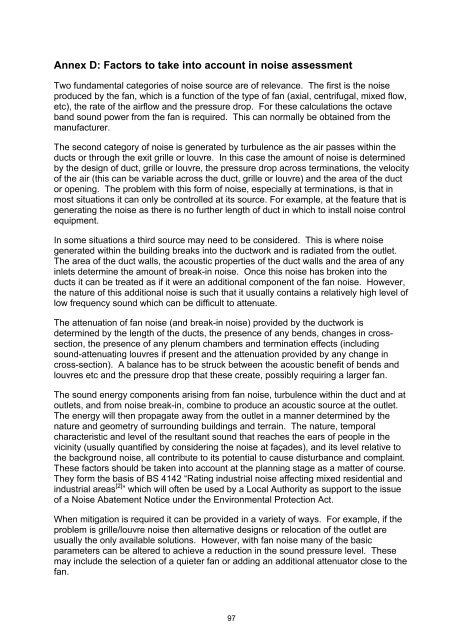Guidance on the Control of Odour and Noise from ... - Defra
Guidance on the Control of Odour and Noise from ... - Defra
Guidance on the Control of Odour and Noise from ... - Defra
Create successful ePaper yourself
Turn your PDF publications into a flip-book with our unique Google optimized e-Paper software.
Annex D: Factors to take into account in noise assessment<br />
Two fundamental categories <strong>of</strong> noise source are <strong>of</strong> relevance. The first is <strong>the</strong> noise<br />
produced by <strong>the</strong> fan, which is a functi<strong>on</strong> <strong>of</strong> <strong>the</strong> type <strong>of</strong> fan (axial, centrifugal, mixed flow,<br />
etc), <strong>the</strong> rate <strong>of</strong> <strong>the</strong> airflow <strong>and</strong> <strong>the</strong> pressure drop. For <strong>the</strong>se calculati<strong>on</strong>s <strong>the</strong> octave<br />
b<strong>and</strong> sound power <strong>from</strong> <strong>the</strong> fan is required. This can normally be obtained <strong>from</strong> <strong>the</strong><br />
manufacturer.<br />
The sec<strong>on</strong>d category <strong>of</strong> noise is generated by turbulence as <strong>the</strong> air passes within <strong>the</strong><br />
ducts or through <strong>the</strong> exit grille or louvre. In this case <strong>the</strong> amount <strong>of</strong> noise is determined<br />
by <strong>the</strong> design <strong>of</strong> duct, grille or louvre, <strong>the</strong> pressure drop across terminati<strong>on</strong>s, <strong>the</strong> velocity<br />
<strong>of</strong> <strong>the</strong> air (this can be variable across <strong>the</strong> duct, grille or louvre) <strong>and</strong> <strong>the</strong> area <strong>of</strong> <strong>the</strong> duct<br />
or opening. The problem with this form <strong>of</strong> noise, especially at terminati<strong>on</strong>s, is that in<br />
most situati<strong>on</strong>s it can <strong>on</strong>ly be c<strong>on</strong>trolled at its source. For example, at <strong>the</strong> feature that is<br />
generating <strong>the</strong> noise as <strong>the</strong>re is no fur<strong>the</strong>r length <strong>of</strong> duct in which to install noise c<strong>on</strong>trol<br />
equipment.<br />
In some situati<strong>on</strong>s a third source may need to be c<strong>on</strong>sidered. This is where noise<br />
generated within <strong>the</strong> building breaks into <strong>the</strong> ductwork <strong>and</strong> is radiated <strong>from</strong> <strong>the</strong> outlet.<br />
The area <strong>of</strong> <strong>the</strong> duct walls, <strong>the</strong> acoustic properties <strong>of</strong> <strong>the</strong> duct walls <strong>and</strong> <strong>the</strong> area <strong>of</strong> any<br />
inlets determine <strong>the</strong> amount <strong>of</strong> break-in noise. Once this noise has broken into <strong>the</strong><br />
ducts it can be treated as if it were an additi<strong>on</strong>al comp<strong>on</strong>ent <strong>of</strong> <strong>the</strong> fan noise. However,<br />
<strong>the</strong> nature <strong>of</strong> this additi<strong>on</strong>al noise is such that it usually c<strong>on</strong>tains a relatively high level <strong>of</strong><br />
low frequency sound which can be difficult to attenuate.<br />
The attenuati<strong>on</strong> <strong>of</strong> fan noise (<strong>and</strong> break-in noise) provided by <strong>the</strong> ductwork is<br />
determined by <strong>the</strong> length <strong>of</strong> <strong>the</strong> ducts, <strong>the</strong> presence <strong>of</strong> any bends, changes in crosssecti<strong>on</strong>,<br />
<strong>the</strong> presence <strong>of</strong> any plenum chambers <strong>and</strong> terminati<strong>on</strong> effects (including<br />
sound-attenuating louvres if present <strong>and</strong> <strong>the</strong> attenuati<strong>on</strong> provided by any change in<br />
cross-secti<strong>on</strong>). A balance has to be struck between <strong>the</strong> acoustic benefit <strong>of</strong> bends <strong>and</strong><br />
louvres etc <strong>and</strong> <strong>the</strong> pressure drop that <strong>the</strong>se create, possibly requiring a larger fan.<br />
The sound energy comp<strong>on</strong>ents arising <strong>from</strong> fan noise, turbulence within <strong>the</strong> duct <strong>and</strong> at<br />
outlets, <strong>and</strong> <strong>from</strong> noise break-in, combine to produce an acoustic source at <strong>the</strong> outlet.<br />
The energy will <strong>the</strong>n propagate away <strong>from</strong> <strong>the</strong> outlet in a manner determined by <strong>the</strong><br />
nature <strong>and</strong> geometry <strong>of</strong> surrounding buildings <strong>and</strong> terrain. The nature, temporal<br />
characteristic <strong>and</strong> level <strong>of</strong> <strong>the</strong> resultant sound that reaches <strong>the</strong> ears <strong>of</strong> people in <strong>the</strong><br />
vicinity (usually quantified by c<strong>on</strong>sidering <strong>the</strong> noise at façades), <strong>and</strong> its level relative to<br />
<strong>the</strong> background noise, all c<strong>on</strong>tribute to its potential to cause disturbance <strong>and</strong> complaint.<br />
These factors should be taken into account at <strong>the</strong> planning stage as a matter <strong>of</strong> course.<br />
They form <strong>the</strong> basis <strong>of</strong> BS 4142 “Rating industrial noise affecting mixed residential <strong>and</strong><br />
industrial areas [2] ” which will <strong>of</strong>ten be used by a Local Authority as support to <strong>the</strong> issue<br />
<strong>of</strong> a <strong>Noise</strong> Abatement Notice under <strong>the</strong> Envir<strong>on</strong>mental Protecti<strong>on</strong> Act.<br />
When mitigati<strong>on</strong> is required it can be provided in a variety <strong>of</strong> ways. For example, if <strong>the</strong><br />
problem is grille/louvre noise <strong>the</strong>n alternative designs or relocati<strong>on</strong> <strong>of</strong> <strong>the</strong> outlet are<br />
usually <strong>the</strong> <strong>on</strong>ly available soluti<strong>on</strong>s. However, with fan noise many <strong>of</strong> <strong>the</strong> basic<br />
parameters can be altered to achieve a reducti<strong>on</strong> in <strong>the</strong> sound pressure level. These<br />
may include <strong>the</strong> selecti<strong>on</strong> <strong>of</strong> a quieter fan or adding an additi<strong>on</strong>al attenuator close to <strong>the</strong><br />
fan.<br />
97
















